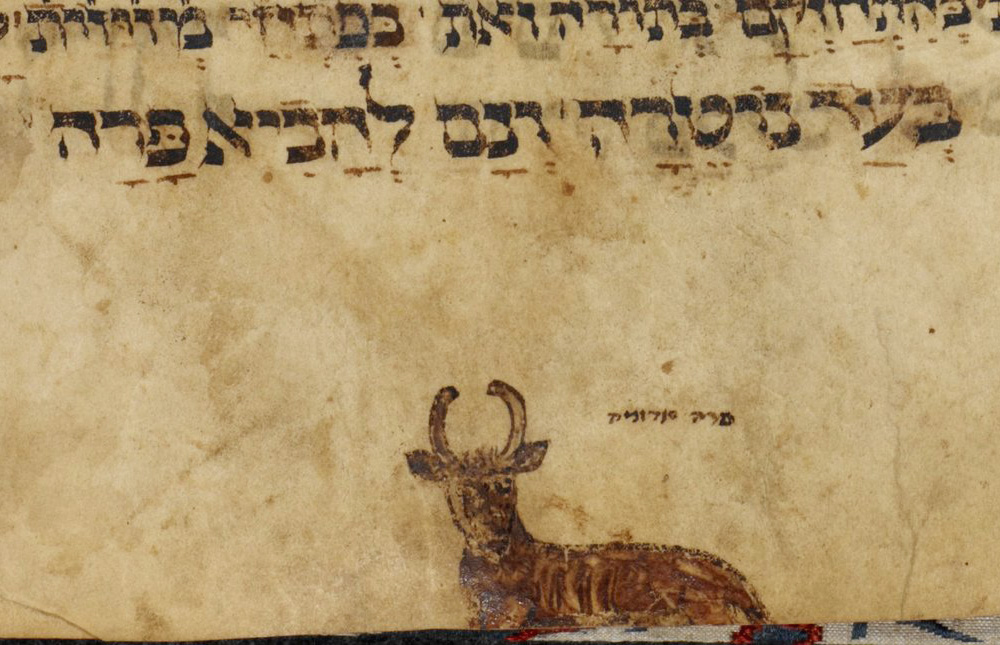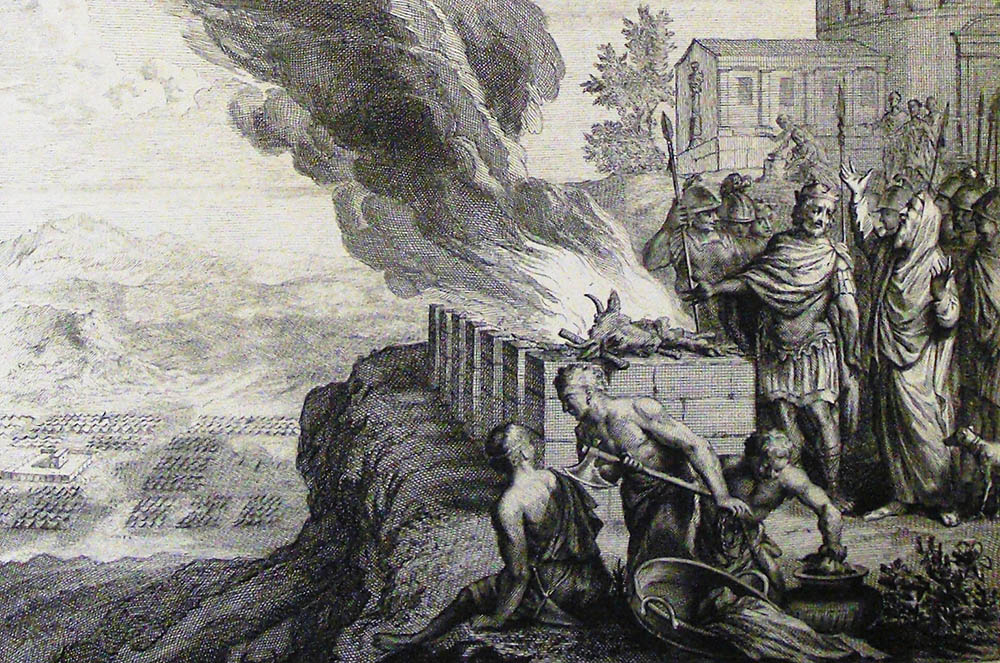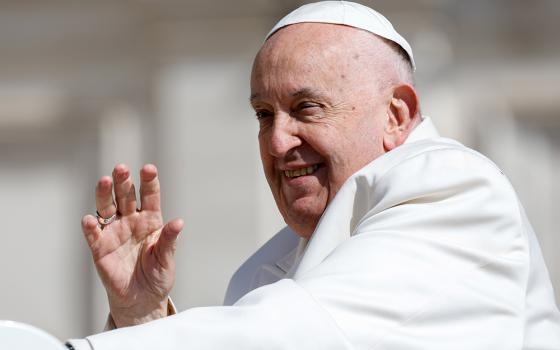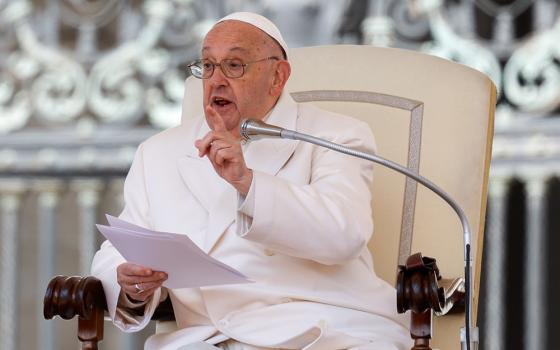
A miniature of a red heifer is seen in the lower margin illustrating a liturgical poem in Hebrew for Shabbat Parah, 1349. (Picryl)
Editor's note: This is Part 1 of a two-part series on the Ceremony of the Red Heifer. Read Part 2 here: "Black Elk, White Buffalo Woman and the mystery of the red heifer ceremony."
The parah adumah, or red heifer, is in the news these days.
Some Jews and dispensationalist Christians are working to revive an ancient ceremony that they see as a prophecy of the restoration of the Temple and the coming of the Messiah. Many Muslims see this as a threat to Al-Aqsa Mosque, which stands on the Temple Mount. In Catholic tradition, the red heifer ceremony has meaning in that Jesus performed it in his passion and through it revealed the character of God and the nature of God's salvific work, which flows through the heart of nature.
Now, the internet is buzzing with rumors that the ceremony of the red heifer could happen again at the Mount of Olives this April during Passover.
In scripture, the ceremony is found in Numbers 19. After the Israelites have escaped slavery in Egypt, wandered through the desert and received the Law at Sinai, they are preparing to enter the Holy Land when God gives Moses and Aaron this ceremony.
A red heifer — a female cow that has not borne a calf — is sacrificed to the east of the tabernacle outside the camp. Her blood is sprinkled seven times toward the tabernacle before she is burned in her entirety, with red cloth, hyssop and cedar tossed into the fire. The heifer's ashes are gathered, mixed with spring water, and sprinkled on the people to make clean those made impure by contact with death.
The red heifer, like the wild ox of Job in never being 'blemished' by the submission of a yoke, harkens back to its wild ancestors.
The ceremony of the red heifer is unique and puzzling for several reasons. Unlike the other sacrifices of the Mosaic covenant, this one occurs not at the altar, but outside the camp. All other sacrificial animals are male, this victim is female. The other sacrifices are regularly repeated, this one is recorded as only having been done nine times. Only this ceremony stipulates the color of the animal. And the heifer must never have been yoked.
Most commentators have had a difficult time interpreting what Barry Holtz calls "the most mysterious of all Jewish rituals." The uniqueness of the ceremony led many to see it stemming from a pre-Mosaic tradition, what Henry Preserved Smith called "obvious" in 1909: "We have in the rite of the heifer a veritable superstitio, a survival from animistic religion naturalized in the law of Israel."
Indeed, the parallels with other tribal contexts that I've studied and experienced jump out. Uniquely colored animals are often honored as sacred, most prominently albinos, like the white buffalo in Lakota tradition. Ceremonies for horned animals, essential food sources and sources of spiritual power, are common.
Take the Sun Dance, a widespread Indigenous ceremony of the North American Great Plains. In it the people honor the buffalo for giving their flesh for food and shelter. In the process, the people accrue spiritual power that, in the words of Servant of God Nicholas Black Elk, "the people may live."
The location of the ceremony of the red heifer in the Book of Numbers is a clue to its "animistic" character. Shortly after God gives the ceremony, the king of Moab calls Balaam, a famous shaman, to curse the advancing Israelites. Balaam conducts four successive ceremonies, sacrificing seven bulls and seven rams on different mountains. Each time the Lord tells him not to curse but bless the Israelites, twice saying, "God brings them out of Egypt with horns like that of a wild ox" (Numbers 23:22, 24:8).

Balak's sacrifices (Numbers 23:24) are depicted in a print from the Phillip Medhurst Collection of Bible illustrations in the possession of Revd. Philip De Vere at St. George’s Court, Kidderminster, England. (Wikimedia Commons/Philip De Vere, CC BY-SA 3.0)
God as a wild ox connects to the prominent use of horns in Hebrew ceremonies of liturgical and royal power. Horns adorn the altars in the Temple where horned animals and incense are sacrificed. Horns, particularly in the anointing of kings, bestow "wild" sacred power as seen in Psalm 92: "You have given me the strength of a wild ox; you have poured rich oil upon me."
Wild animals reflect untamed divine power, illuminated beautifully by Job 39-42 and exemplified by the wild ox that will never plough the fields for humans (39:10). Wild animals could never be sacrificed as they belong not to humans, but to God.
Yet the red heifer, like the wild ox of Job in never being "blemished" by the submission of a yoke, harkens back to its wild ancestors. Like the Jerusalem Temple, the red heifer is a limited human copy of a wild divine reality.
What then does this kind of "wild" sacrifice mean? In religious contexts dominated by paradigms of sin and depravity, justification and otherworldly salvation, it's easy to miss the obvious emphasis on power and life. The impurity addressed by the red heifer ceremony has nothing to do with sin, but rather with contact with death, much of which comes from communal duties, like honoring and burying the dead.
Though differing from other sacrifices of the law, the red heifer ceremony is best seen within the positive character of sacrifice in Hebrew ceremonial life, which works to restore wholeness to the community.
Like prayer, sacrifices draw us close to God. The Hebrew word qorbanot, usually translated as "sacrifice," comes from the root "to draw near." This is made more explicit by the burning of sacrifices, often referred to as sweet-smelling oblations. "The word for 'incense,' ketoret, reflects the Aramaic word keter, which means 'bond,' " explains Yehuda Shurpin.
Advertisement
Taken as a whole, then, the red heifer draws God and the people close and restores a particular relationship. Red is the color of blood and the color of the earth. In the Hebrew language: blood, red, earth and Adam all come from the same root.
Blood is life itself, Leviticus explains, right after giving the rules about hunting (Leviticus 17:11). The sprinkling of the lustral water transforms the people with the power of blood and earth, which is life.
The sacrifice of blood and earth that draws people near to and binds them to God led many Christian commentators to connect the red heifer to Christ. The Epistle to the Hebrews alludes to this: "Jesus also suffered outside the gate, to consecrate the people by his own blood" (13:12) and if "the sprinkling of a heifer's ashes can sanctify those who are defiled so that their flesh is cleansed, how much more will the blood of Christ" (Hebrews 9:13-14).
The Epistle of Barnabas, written within a century after Christ's death, makes this explicit: "The calf is Jesus." St. Augustine agreed.
These aren't superficial parallels imposed on the red heifer and Jesus. The red heifer ceremony was traditionally conducted east of the Temple on the Mount of Olives, where the Garden of Gethsemane is located. In his agony, Jesus sweated blood and turned red. Like the red heifer, Jesus was immolated outside the Temple and lives on in lustral water that gives power for us to become daughters and sons of God.
Salvation, too often reduced to formulas and words, lives in the raw power of the wild ox willingly domesticated for us as the red heifer, of blood and earth transformed by fire. Jesus has a uniquely female sacrificial power, the power of shedding one's own blood and sometimes even dying to birth new life. And this wildness and female sacrificial power are essential characteristics of the drawing near and binding power of salvation, of how "Christ loved us and handed himself over for us as a sacrificial offering to God for a fragrant aroma" (Ephesians 5:2).











